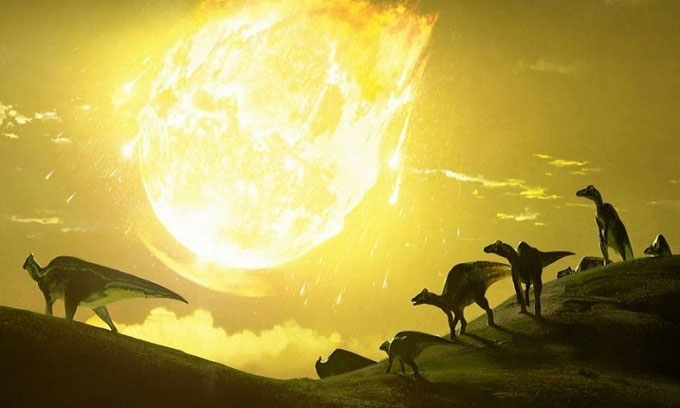Dangerous flying angle of asteroid erasing dinosaurs
The meteorite caused the extinct dinosaur to crash to Earth 66 million years ago at its steepest angle, maximizing the release of gas to cause climate change.
The research community unanimously agreed that the 200km Chicxulub crater in Mexico today formed when a giant meteorite crashed down, killing 3/4 of the life on Earth. But the flight path and direction of the meteorite are still controversial. In a study published on May 26 in the journal Nature Communication, the international team said that their 3D simulation indicated the meteorite fell to the ground at an angle of 40 - 60 degrees. Lead researcher Gareth Collins, a professor of planetary science at the School of Earth Sciences and Engineering at Imperial College London, described the situation as the worst for dinosaurs.

Giant meteorite creates Chicxuclub crater 200km wide. (Photo: Fox).
"Asteroid impact releases enormous amounts of climate change gas into the atmosphere, fueling a series of events that led to the extinction of the dinosaurs. This process is likely to be made worse by a meteor crash in deadliest corner, " Collins said. "We know this is the worst situation because it causes more toxic debris to hit the upper atmosphere and scatter everywhere, leading to the atomic winter."
The collision produces billions of tons of sulfur and many other gases in the atmosphere, obscuring the Sun and causing the Earth's temperature to plummet. The team at Imperial College London, UK, Freiburg University, Germany and the University of Texas, USA, examined the shape and structure of the impact crater as well as soil samples taken from it. "Despite being buried nearly a kilometer below the sedimentary rock, geophysical data reveals many things about the pit structure, reflecting the direction and angle of impact , " said Auriol Rae, a postdoctoral researcher at the University. Freiburg, co-author of the study, said.
This information and other data are used to build a model to simulate Chicxulub crater formation, helping researchers determine the direction and angle of flight of asteroids. They weighed 4 different angles: 90, 60, 45 and 30 degrees. The team believes that the 60-degree angle is most likely based on the relationship between the three positions: the center of the pit, the rim and the center of the mantle rock pushed up to a depth of 30 km below the pit.
At Chicxulub crater, these positions are arranged in southwest - northeast direction and 3D simulation at 60 degree angle gives nearly identical results. According to the team, this collision angle produces more climate-changing gases such as sulfur and carbon dioxide than shallow or near vertical impacts.
- If flying dinosaurs were not extinct, could humans tame them into mounts?
- Decode the mystery of flying dinosaurs
- Discover the most bird-like fossil flying dinosaurs
- New discovery of dinosaurs 'aerial assassins'
- First evidence of dinosaurs 'flying' to eat birds
- How do dinosaur flights take place?
- A 2,000-meter asteroid could crash into Earth in the future
- Asteroid travels through the Earth
- Giant meteorite is about to fly past Earth
- Winged dinosaurs can't fly
- Extinct dinosaurs make ostriches stop flying
- How does the dinosaur learn to fly?
 'Fine laughs' - Scary and painful torture in ancient times
'Fine laughs' - Scary and painful torture in ancient times The sequence of numbers 142857 of the Egyptian pyramids is known as the strangest number in the world - Why?
The sequence of numbers 142857 of the Egyptian pyramids is known as the strangest number in the world - Why? History of the iron
History of the iron What is alum?
What is alum? How to make the ice on the water go the farthest?
How to make the ice on the water go the farthest?  Find a photo corner that gives you the perfect picture
Find a photo corner that gives you the perfect picture  Perfect throwing shots
Perfect throwing shots  Why is never lost?
Why is never lost?  20 photos prove just changing the angle of shooting, you will have moments of magic
20 photos prove just changing the angle of shooting, you will have moments of magic  New way to filter light
New way to filter light 